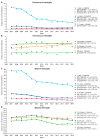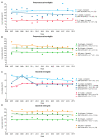Trends in Pneumococcal and Bacterial Meningitis in Brazil from 2007 to 2019
- PMID: 37631847
- PMCID: PMC10459388
- DOI: 10.3390/vaccines11081279
Trends in Pneumococcal and Bacterial Meningitis in Brazil from 2007 to 2019
Abstract
The pneumococcal conjugate vaccination (PCV) was introduced into the Brazilian Childhood National Immunization Program in 2010; however, universal pneumococcal vaccination for older adults has not been implemented yet. Our aim is to evaluate the trends in pneumococcal meningitis incidence and case fatality rate (CFR) across all age groups from 2007 to 2019 using data from the National Surveillance System. The pre-PCV (2007-2009) and post-PCV (2011-2019) periods were compared; changes in incidence and CFR were assessed by joinpoint regression. Additional analyses of bacterial meningitis were performed to compare the patterns and trends. Over the 13-year period, 81,203 and 13,837 cases were classified as bacterial and pneumococcal meningitis, respectively. S. pneumoniae was the main etiological agent of bacterial meningitis in adults aged ≥50 years and the most lethal in all age groups. In the post-PCV period, a 56.5% reduction in the average incidence was seen in pneumococcal meningitis in the pediatric population. In contrast, there was an increasing trend among adults. The CFR for pneumococcal and bacterial meningitis remained stable in most age groups during the study period. These findings highlight the value of expanding pneumococcal vaccination policies, including vaccines that provide better indirect protection from children to adults and broadening vaccination to older adults.
Keywords: Brazil; epidemiology; invasive pneumococcal disease; meningitis; vaccination.
Conflict of interest statement
Ana Luiza Bierrenbach is a medical scientific consultant and received honoraria from MSD Brazil; Cintia Irene Parellada, Thais das Neves Fraga Moreira and Paula Mendonça Batista are employees of MSD Brazil, a subsidiary of Merck & Co., Inc., Rahway, NJ, USA, who may own stock and/or hold stock options in Merck & Co., Inc., Rahway, NJ, USA; Juan Carlos Orengo is an employee of Merck Sharp & Dohme LLC, a subsidiary of Merck & Co., Inc., Rahway, NJ, USA, who may own stock and/or hold stock options in Merck & Co., Inc., Rahway, NJ, USA; Ariane de Jesus Lopes de Abreu, Marina Birck, Carolina Zampirolli Dias and Guilherme Silva Julian were employees of IQVIA Brazil, which was contracted by MSD Brazil to conduct the study.
Figures





References
Grants and funding
LinkOut - more resources
Full Text Sources
Medical

